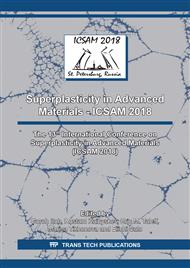p.250
p.256
p.262
p.267
p.273
p.278
p.284
p.290
p.296
Influence of Temperature of Severe Plastic Deformation and Aging on Microstructure, Mechanical Properties and Electrical Conductivitiy of the Cu-Cr-Zr Alloy
Abstract:
The article studies an influence of temperature of severe plastic deformation (SPD) and post-deformation heat treatment on microstructure, mechanical properties and thermal stability of the Cu-0.5Cr-0.2Zr alloy. The results demonstrate that strength is considerably increased to 900 MPa by high pressure torsion (HPT) at room temperature. Subsequent ageing at 450 °С during 1 hour leads to a decay of solid solution and an allocation of dispersion particles that further incrises strength to 900 MPa, restores electrical conductivity to 70% IACS (International annealed copper standard) and enhances thermal stability of the alloy. When deformation temperature is increased to 300°С, strength is 690 MPa that is lower than in the case of deformation at room temperature that is related to reversion process at deformation. Additional a aging does not lead to an increase of strength characteristics.
Info:
Periodical:
Pages:
273-277
Citation:
Online since:
July 2018
Authors:
Keywords:
Price:
Сopyright:
© 2018 Trans Tech Publications Ltd. All Rights Reserved
Share:
Citation:


